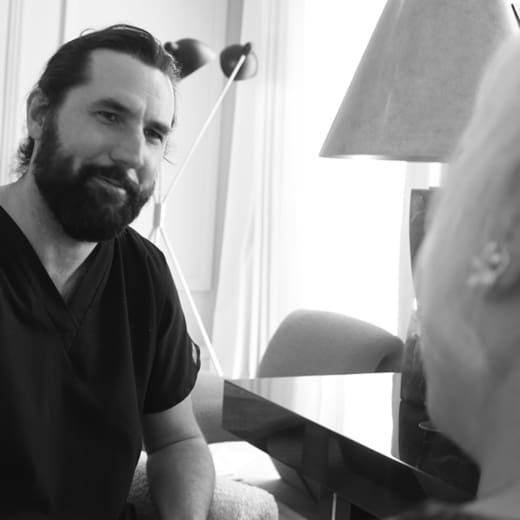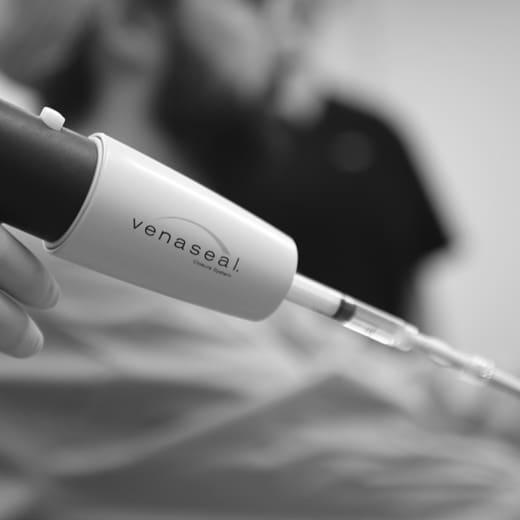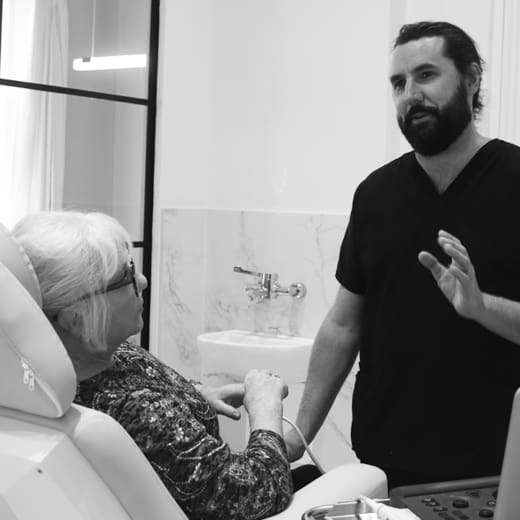McKeown Medical
167 Bath Street, Glasgow, G2 4SQ
Date posted — 2.10.24
If you’re struggling with the discomfort, swelling, or unsightly appearance of varicose veins, Radiofrequency Ablation (RFA) could be the solution you’ve been looking for. This minimally invasive procedure uses radiofrequency energy to target and close off problematic veins, providing long-lasting relief with less discomfort and downtime than traditional surgery.
In this guide, we’ll explore everything you need to know about RFA – from how it works to what you can expect during the procedure, what the recovery is, and the benefits it offers over other treatment options and the benefits some newer treatments like VenaSeal™ might have over RFA. Ultimately, there are lots of choices when it comes to treating varicose veins.

RFA is a minimally invasive medical procedure used to treat varicose veins by using radiofrequency energy to heat and close off the affected veins. It is part of a group of techniques referred to as ‘endovascular’ procedures because they involve operating inside the vein rather than outside of it in the traditional approach. RFA involves inserting a small catheter into the vein, where radiofrequency energy is delivered, causing the vein walls to contract, collapse, and eventually be absorbed by the body.
RFA was introduced in the late 1990s and early 2000s as an alternative to more invasive surgical treatments like vein stripping. Around the same time, another option known as endovenous laser ablation (EVLA) was also developed.
EVLA employs a very similar technique by delivering heat to destroy the inside of the problematic blood vessels, although it uses laser energy to deliver the heat. Both RFA and EVLA are similarly very effective, although RFA is associated with fewer side effects and is generally considered to be the superior method.
Dr Alex Vesey is our expert consultant vascular surgeon who heads up our varicose vein team. Listen to him explain the RFA treatment.

Before: Before the procedure, you’ll first have a consultation with a specialist vascular surgeon who will assess your varicose veins from taking a medical history, performing a thorough examination and an ultrasound scan to assess the anatomy of your veins. This helps determine the best veins to treat and ensures that RFA is the right option for you. On the day of the procedure, you’ll be asked to wear loose-fitting clothing and underwear that you don’t mind getting antiseptic on. You will be asked to sign an informed consent form before you go into the treatment room (a copy of this will be emailed to you in advance so you have plenty of time to read before you sign).
During: The procedure begins with the patient lying down on the treatment table and the affected leg is then cleaned and sterile drapes are applied. The doctor then makes a small incision near the knee or lower leg to insert a thin catheter into the problematic vein, guided by ultrasound imaging for precise placement. The doctor then injects a high volume of dilute anaesthetic – known as tumescent anaesthetic – along the length of the vein to be treated. As well as providing anaesthesia, this also helps to absorb the heat that is delivered to the vein during the procedure and reduces the chances of injuring surrounding tissues, like nerves. The catheter position is then rechecked and radiofrequency energy is delivered through the catheter, heating the vein walls and causing them to collapse and seal shut. This process is repeated along the length of the vein, effectively closing it off. The procedure typically takes about 30 to 60 minutes.
After: After the RFA procedure, a compression bandage or stocking is applied to the treated leg to help reduce swelling and promote healing. Most patients can stand up and walk immediately after the procedure, which is encouraged to help circulation. You may experience some discomfort, bruising, or swelling, but these symptoms usually subside within a few days. It’s generally recommended to avoid strenuous activities for about a week, but most people can return to their normal routines within a day or two. We will arrange to see you back in the clinic to assess the results, typically a few months after treatment since this is how long it takes for the veins to be reabsorbed by the body and for us to be able to assess the outcome.
Endovascular treatment with RFA offers significant benefits over traditional surgery for treating varicose veins.
One of the main advantages is its minimally invasive nature, which involves only a small incision and causes far less trauma to the surrounding tissues compared to traditional vein-stripping surgery. This leads to a quicker recovery time, allowing patients to return to their normal activities, often within a day or two, as opposed to the longer downtime required after surgery. RFA also typically results in less pain, bruising, and scarring, which improves patient satisfaction both during and after the procedure.
Additionally, because RFA uses radiofrequency energy to precisely target and close off the affected veins, it reduces the risk of complications such as nerve damage, which can be more common in traditional surgical approaches. Not everyone is suitable for RFA – which is why your initial consultation and ultrasound scan assessment are so important to make sure you get the best treatment option for your particular condition.

VenaSeal™ is a more recent innovative and effective option for the endovascular treatment of varicose veins, gaining FDA approval in 2015. VenaSeal™ uses a medical adhesive instead of heat to close off problematic veins.
The procedure involves inserting a small catheter into the vein and applying the adhesive, which bonds the vein walls together, causing the vein to seal shut and be gradually absorbed by the body. Compared to RFA, VenaSeal™ offers several advantages: it requires no heat or tumescent anaesthetic injections, which can reduce discomfort and eliminate the need for compression stockings after the procedure.
Additionally, VenaSeal™ has an even quicker recovery time – often allowing patients to resume normal activities almost immediately. While RFA remains a highly effective treatment with a proven track record, VenaSeal™ offers the same levels of effectiveness with less pain, inconvenience and downtime which is why it now accounts for around 50% of varicose vein treatment in the USA.
We are the first clinic in Scotland to introduce what is now considered to be the gold standard treatment for varicose veins.
If you’d like to find out if Radiofrequency Ablation (RFA) is the right treatment for you, the first step is to fill out our online consultation form. From there, our team will be able to arrange an initial consultation and ultrasound scan, and we can work together to create a treatment plan that is tailored to your needs.

Radiofrequency ablation (RFA) and endovenous laser ablation (EVLA) are two minimally invasive treatments used to effectively treat varicose veins, but...

When it comes to treating varicose veins, VenaSeal™ has emerged as a revolutionary option that offers a minimally invasive and...

Varicose veins are enlarged, twisted veins that often appear just under the skin, primarily in the legs and feet.
1 / 3
2 / 3
3 / 3

Radiofrequency ablation (RFA) and endovenous laser ablation (EVLA) are two minimally invasive treatments used to effectively treat varicose veins, but...

When it comes to treating varicose veins, VenaSeal™ has emerged as a revolutionary option that offers a minimally invasive and...

Varicose veins are enlarged, twisted veins that often appear just under the skin, primarily in the legs and feet.
Relfydess is the newest toxin on the market and we have been working hard in the clinic to test the claims of the manufacturer. Is it really as good as they claim?
This patient kindly allowed us to test the difference with her: she had Relfydess on the left side of her face and her usual Botox on the right, to compare how the two treatments performed. These photos were taken three weeks after treatment.
The Relfydess kicked in a day or two faster. However, what is really interesting is that on the side we treated with Reflydess she got a good result that didn`t need a top-up, whilst the other side did need a top-up, which you can see in these photos.
I will keep posting more updates as we find them about this new product!

I’ve been treating patients with Relfydess for the past few weeks now, and I was really curious to know how they were getting on. So, we reached out to the first 97 people who had the treatment and asked them how it felt, how quickly it worked, and whether they’d do it again.
In this video, I’m sharing what they told me – and a bit of my own perspective on how it’s shaping up compared to the other wrinkle treatments we have available. It’s still early days, but the feedback so far has been really interesting!

As we approach the summer holidays and get into the middle of wedding season, filler season is well under way! Thank you to this lovely patient for allowing us to share her results following a volumetric facelift, all performed with injections of dermal filler.
Her main concern was the development of jowls and the way it was starting to affect the shape of her lower face. By carefully restoring volume in the right areas, we were able to subtly lift and contour creating a more defined jawline while keeping everything natural and in harmony with the rest of her features.
This is a few weeks post-treatment and she`s absolutely over the moon. What do you think?
Find out more about our volumetric facelift treatment at the link in our profile.

Thank you to our lovely patient for allowing us to share these photos with you.
She came to see us with prominent varicose veins that had been bothering her for years. Just 8 weeks after treatment with VenaSeal™, you can already see a noticeable difference and the results will continue to improve as the treated veins fade further over the months ahead.
VenaSeal™ is a walk-in, walk-out treatment that uses medical adhesive to close the affected veins. No surgery, no compression stockings, and no downtime which made it the ideal option for this patient.
We’re so pleased with how things are progressing already. More to come as her results continue to develop.
Find out more about VenaSeal™ and our other treatment options for varicose veins at the link in our profile.

Another astonishingly great result from our fabulous surgeon @bramhallplasticsurgery.
This lovely patient was bothered by the excess skin on her upper eyelids. Although the surgical procedure itself is quite straightforward, the aesthetic judgement - how much to remove and how much to leave behind - is where the true skill lies, and our Russell is exceptionally talented when it comes to this.
The patient is over the moon with her results. What do you think?

We’re now well into CoolSculpting® season, with lots of our patients booking in to treat areas of stubborn fat in time for the summer holidays!
CoolSculpting® is a non-surgical treatment that uses controlled cooling to reduce fat in targeted areas – with no needles, no downtime, and long-lasting results. It’s ideal for areas like the abdomen, thighs, arms, and under the chin.
For our patients who love their results and want to keep going, we’ve introduced the CoolSculpting® Membership Programme. Once you’ve completed 10 cycles, you’ll unlock access to our lowest rate – just £350 per cycle and you can return for further cycles at this exclusive price, whenever it suits you.
If you`re interested in CoolSculpting®, or have any questions, send us a message or visit the link in our profile.

Been thinking about a hair transplant? We have limited consultation slots with the fabulous Dr Mani available if you`d like to discuss your options for restored hair.
In the meantime, meet Adam. He had his transplant last month with Dr Mani here at McKeown Medical – and filmed this video the very next day with an honest account of why he decided to go ahead and what the experience was like.
We’ll be sharing more soon as Adam’s journey continues – including his results over the coming months.
If you’ve been thinking about hair restoration, drop us a message and we`ll be delighted to chat you through your options.
See more about our hair transplant treatments at the link in our profile.

Heavy periods aren’t something you just have to put up with. They’re common, but that doesn’t mean they’re normal.
As part of our expanding women’s health service, we’re now offering private access to the NovaSure®️ procedure – a safe, effective treatment for heavy menstrual bleeding that can be performed as a walk-in, walk-out appointment under local anaesthetic.
Here’s our consultant gynaecologist @driainmartin demonstrating how the procedure works and why this treatment has been such a game-changer for women dealing with disruptive, excessive bleeding.
Over 90% of women experience a significant reduction in symptoms after NovaSure, and many are able to avoid more invasive surgery altogether.
We’re proud to be the first private clinic in Scotland to offer this treatment.
If heavy periods are affecting your quality of life, we’re here to help.
See more details at the link in our profile.

Non-surgical rhinoplasty is one of my favourite procedures that we offer in the clinic. The addition of small amounts of filler to the correct locations can help to support the nose and create a more harmonious profile.
This young lady who came in today has always been concerned by the bump on her nose and left not long after feeling so much more comfortable with her appearance.
What do you think?
Find out more about non-surgical rhinoplasty at the link in our profile.
